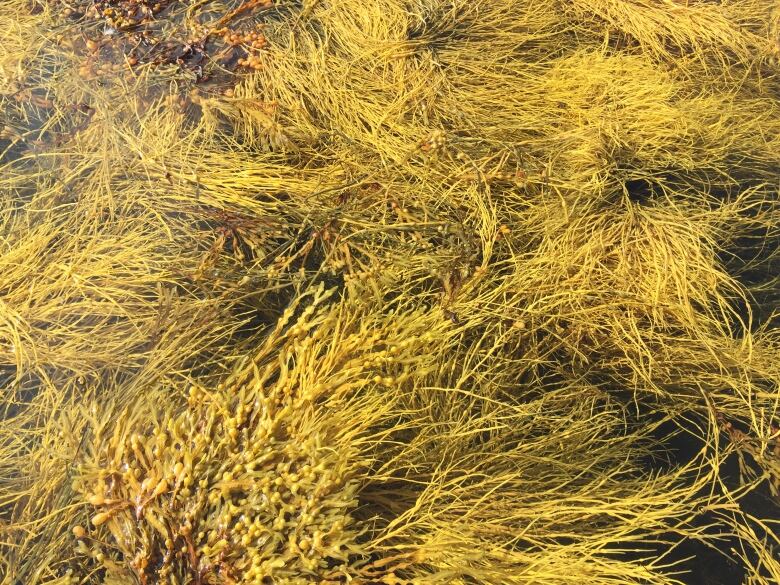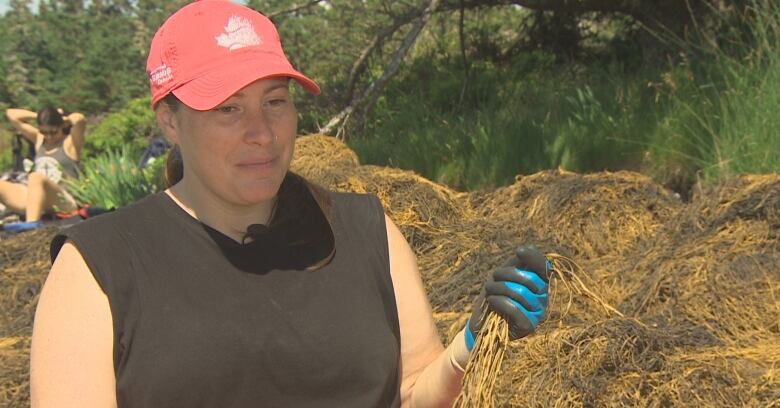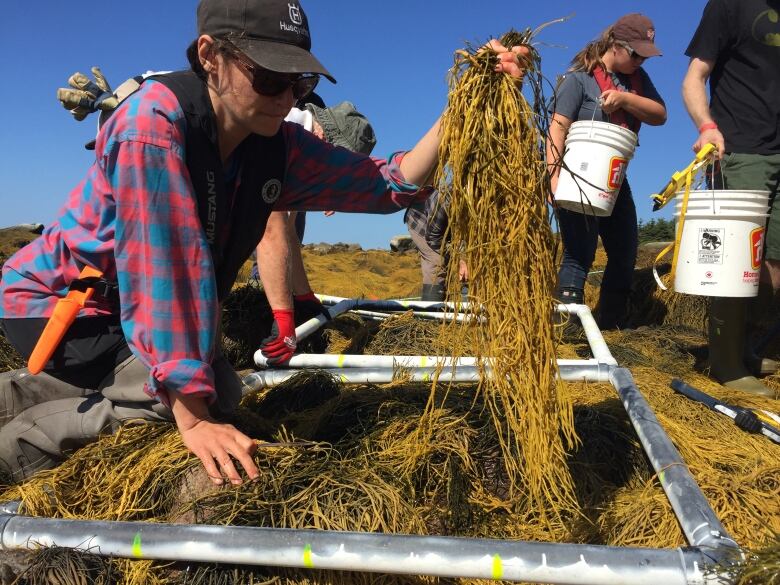Research may reveal mysteries of Nova Scotia seaweed
Rockweed estimates currently done by hand, a slow and difficult process

It's harvested by the tonne from Nova Scotia coastlinesand used in products from fertilizer to food.
But researchers still have much to learn about a common plant that forms the basis for hundreds of jobs in the province.
Work by Nova Scotia Community College scientists on the South Shore using new mapping technology may help reveal more about the status of rockweed, a common seaweed that is being harvested and processed in Nova Scotia but shipped around the world.
"This technology is fantastic to be able to estimate how much of this resource is here," said Tim Webster, the lead scientist on the project.
Webster said that information could be helpful to harvesters, who need to leave enough rockweed to be sure the plant continues to grow sustainably.
"As well, for the regulator, the Nova Scotia government, to understand how much of the resource is here in order to, again, protect it for future generations," he said.
Estimating by hand
Rockweed grows like a lawn: the tops of the plants can be clipped off but it will continue to grow back year after year as long as the "holdfast" or root-like area is not touched.
Right now, measuring how much rockweed biomass exists along the coastline is difficult and inexact.

"Typically we've been doing it by hand," said Jean-Sebastien Lauzon-Guay, a research scientist with Acadian Seaplants Limited, the company that buys the majority of the rockweed harvest in Nova Scotia.
"It's very time consuming and we can't possibly measure everything."
The private company employs 250 people in Nova Scotiaand exports to countries such as China and India.
3 years of experiments
Rockweedalso contributes to the income of harvesters who sell to companies like Acadian Seaplants.

Ascophyllum nodosum is the scientific name for rockweed. Lauzon-Guay says Acadian Seaplantsstaff take samples and try to extrapolate information to find out how much biomass is in a whole rockweed bed.
Acadian Seaplants partnered with Webster's group on a three-year cycle of experiments around rockweed. Lauzon-Guay is hopeful the work will yield a new way to estimate the biomass of the rockweed the company wants to harvest.
How it's done
Webster works with the Applied Geomatics Research Group divisionand specializes in mapping. For the past several years, his team has been experimenting with a laser sensor mounted on a plane, taking aerial surveys of the province's coastline.
The sensor is able to distinguish between vegetation and rock. Webster says the maps are able to show the height of the rockweed plants and the height of the rock underneath.
The sensor cannot determine the weight of the plants, but in late Augustthe NSCC researchers designed an experiment they hope will tell them that information.
Before and after surveys
Just outside Shag Harbour, they cut a 20-metre-by-four-metre rectangle in the thick rockweed of the inter-tidal zone.
For every square metre harvested, the team weighed and measured the rockweed that was removed. They will compare before-and-after aerial surveys of the cut areato try to determine if the plant height can show the weight.
"Then we'll put that all back together once we have our data [from the aerial laser sensor], to see if we can kind of match it up," said research associate Candace MacDonald, who managed the site for the rockweed survey.

It has also been a chance for the team to learn more about the plant.
"It's really neat that it's so resilient," she said. "It is everywhere in Nova Scotia and not many people even know what it is."
Why is rockweedbiomass so important?
The province of Nova Scotia regulates rockweed harvest, but it doesn't place any restrictions on how much biomass can be taken. The regulations state harvesting must be done in a sustainable way and that at least 127 millimetres at the bottom of theplant must be left so that it will grow back.
There is some concern that harvesters may be taking too much to use the lawn analogy, cutting the grass too short.
A2013 report from Fisheries and Oceans Canada stated industry harvest rates of up to 25 per cent of the biomass of rockweed allowed the plant to regrow and maintain commercial yield rates.
The report also saidno one, either from industry or third parties, had enough information to determine whether that rate of harvest is harmful to plants and animals that live in the rockweed.

Biology professor David Garbary of St. Francis Xavier University is doing research on the effects of harvesting the species.
His work is not yet ready for publicationbut he wrote in an email to CBC that he regards the harvest as "problematic because of the vast amounts of biomass being removed from the environment and the impact on biodiversity."
Better estimates
According to Lauzon-Guay, AcadianSeaplants harvesters take between 17 and 20 per cent of the company's biomass estimates in any area, leaving behind roughly 80 per cent for regrowth. He says that other studies have shown that year after year, rockweed regrows faster than it is cut, and that there is a minimal impact on other species.
Lauzon-Guay said the company believes the laser sensor work is important because having better biomass estimate information will help industry and the environment.
"It ensures that we're harvesting exactly the right amount, so that the industry remains sustainable," he said.
'We're the first ones'
For Tim Webster and his team, the project has allowed them to map new areas of the South Shore, which can have applications far beyond the rockweed industry.
Webster said the information could also be useful for data on coastal flooding, development, aquaculture, and oil spill response. He said when surveying for one project, the team often finds a new and unexpected piece of information, which is what he personally finds exciting about the work.

"We're basically looking at information and producing maps that have never been seen before. We're the first ones to have done this in this region, and the first time looking at this area using such data," he said.
The rockweedexperiments were funded by the Natural Sciences and Engineering Research Council of Canada (NSERC) at $75,000 per year for three years. Acadian Seaplantscontributed $2,000 in cash for each of the three years, and $35,500 per year in support in the form of staff and use of the company's boat. The Nova Scotiagovernment contributed $5,000 in 2016.












_(720p).jpg)


 OFFICIAL HD MUSIC VIDEO.jpg)
.jpg)



























































































